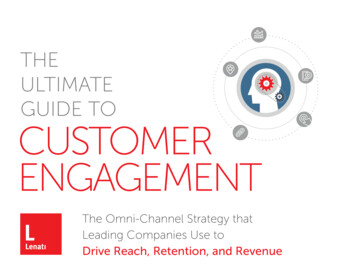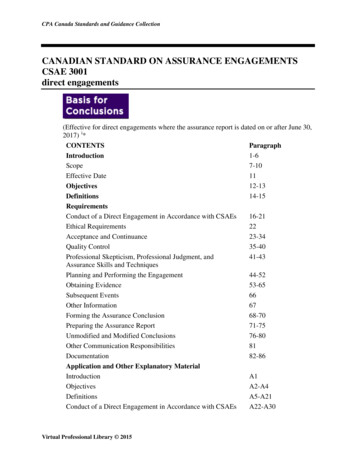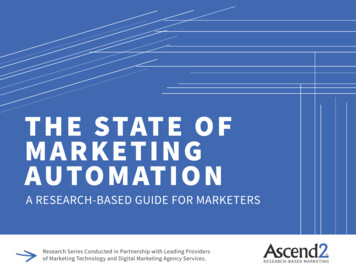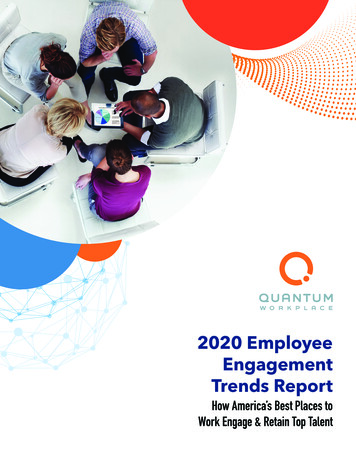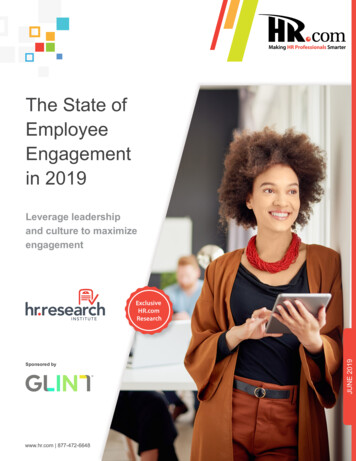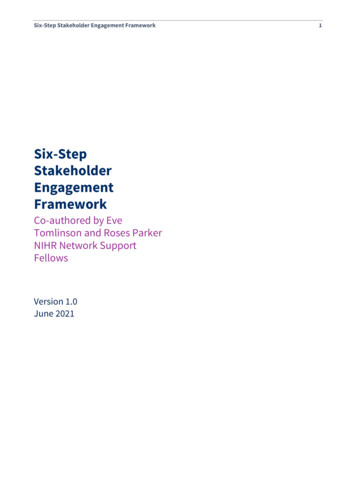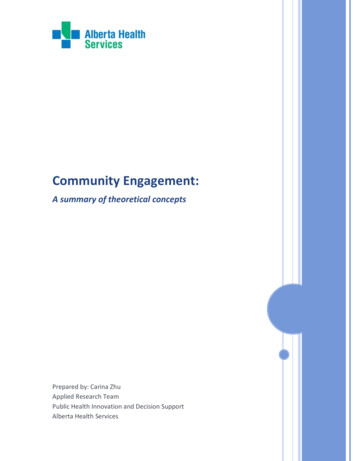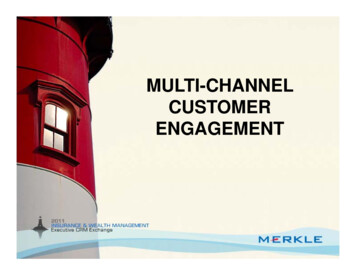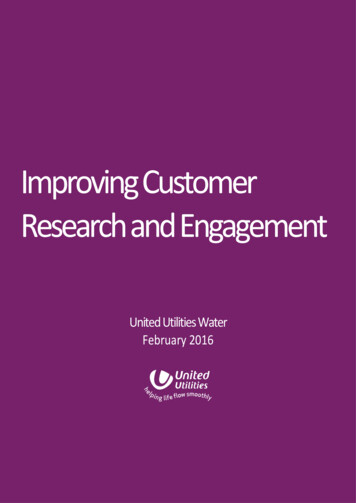
Transcription
Improving CustomerResearch and EngagementUnited Utilities WaterFebruary 2016
ContentsExecutive Summary . 21.Introduction . 52.The need to improve understanding of customer needs . 53.The contribution of behavioural economics to customer research and engagement . 64.A review of the use of willingness to pay . 75.Valuing customer priorities – deriving values from actual water service choices . 96.Valuing customer priorities using market data for related goods – revealed preference107.Obtaining altruistic and non-use values . 118.Overall satisfaction approaches. 129.Improving stated preference surveys . 1310. The proposed framework for choosing the customer research approach . 1411. The framework for valuation . 1512. Conclusions . 18
United Utilities Water LtdImproving Customer Research and EngagementExecutive SummaryPR14 represented a step change in customer engagement in price reviews and we are committedto developing this further for PR19. This paper sets out a potential framework for the approachto customer research and engagement and shows how this could be applied to the variousaspects of service delivery.This summary sets out the framework and its potential application. In the paper the potentialadvantages and disadvantages of the available approaches to customer research are consideredin more detail.Customer research and interaction with customers helps to identify which areas of servicecustomers are dissatisfied with and which they see as priorities for improvement. Monetaryvalues for benefits of potential improvement are needed for carrying out cost-benefit analysisand to contribute to setting incentive rates for Outcome Delivery Incentives (ODIs). At PR14these were predominantly based on Willingness to Pay (WTP) surveys but we recognise thelimitations of this approach and agree that there is scope to use a wider range of information todetermine benefit values. In addition, information should be obtained on values for differentcustomer groups, establishing how values vary between different socio-economic groups andbetween different regions of a company’s area.The diagram below shows how the various elements of engagement can be combined: Customer valuations should be derived from all the available evidence – including moreevidence from observing customer behaviour and from new designs for choiceexperiments. Experiments and trials, continuous engagement, and improved communication should beused to increase customer involvement in service delivery. Behavioural economics gives insights on the effects of psychological, social, cognitive, andemotional factors on economic decisions. These insights can be used in designing customerresearch, in recognising the limitations of any research and analysis, and in designingeffective communication approaches.2
United Utilities Water LtdImproving Customer Research and EngagementWTP surveys are likely to be a part of the valuation approach for most aspects of service. Thereare limits on the extent to which values can be derived from actual customer behaviour. Inaddition, we need to take into account customers’ willingness to pay to resolve service problemswhich they do not actually experience. These altruistic values cannot be derived from observingcustomer decisions. However, a final judgement on the value to be attributed to improvementswill also depend on other engagement and research. The weight which should be given to WTPresults should depend on: Do WTP results match evidence from day-to-day engagement with customers and anyother evidence on priorities? Are WTP results outliers compared with previous results and results from othercompanies? How statistically robust are the results compared with results from other approaches?The importance of carrying out complementary research depends on the conclusions from thesequestions and on: How significant are potential improvements where there is an element of choice overlevels of service? What is the relative importance of prioritisation at a company level and nationalstandards? How much difference would alternative valuations make to business plan proposals?3
United Utilities Water LtdImproving Customer Research and EngagementIn combining the results from a range of evidence, there will inevitably be an element ofjudgement in determining a value to be used for evaluating proposals. Companies should involveCCGs in making these judgements and the balance chosen will also be subject to review throughtesting the overall acceptability of a plan.A framework for determining the appropriate approach to valuation is set out below. A valuebased on observed behaviour is generally preferable but the limitations on obtaining completevalues from such observations means that in many cases WTP results will form a part of theestimate of appropriate value. Customer priorities need to feed in at the beginning, in todecisions about which aspects of service to value and at the end to validate the values arisingfrom research.4
United Utilities Water LtdImproving Customer Research and Engagement1.IntroductionPR14 represented a step change in customer engagement in price reviews and we are committedto developing this further for PR19. Key aspects of this are: Improving customer research so that it more accurately reflects customer priorities. Ensuring that research and engagement is continuous rather than driven by price reviews. Involving customers in service delivery.This paper concentrates on improving customer research, in particular in relation to determiningvaluation of potential improvements, but also considers the closely related issue of increasingcustomer involvement in delivery.The following sections cover:2.The need to improve understanding of customer needs.3.The contribution of behavioural economics to customer research and engagement.4.A review of the use of Willingness to Pay.5.Valuing customer priorities – deriving values from actual water service choices.6.Valuing customer priorities using market data for related goods – revealed preference.7.Obtaining altruistic and non-use values.8.Overall satisfaction approaches9.Improving stated preference surveys10. The proposed framework for choosing the customer research approach11. The framework for valuation12. Conclusions2.The need to improve understanding of customer needsIn its recent December 2015 Water 2020 document, Ofwat stated that:“we would like to see a reduction in the reliance on stated preference survey-basedapproaches and more emphasis on a richer set of evidence to genuinely understandcustomers’ needs and requirements. [ ] This includes making more use of evidenceobtained through their day-to-day contact with customers (such as complaints data,queries and tweets). It also includes thinking about more radical, frontier-shifting,approaches to engaging with customers, such as using revealed preference researchand choice experiments” 1.The wish to change the approach to understanding customer priorities reflects concern thatwillingness to pay surveys may not accurately reflect the value placed on service improvements– there are large differences between values for different companies, and over time, which areunlikely to reflect real differences in customer valuation. In addition, a different approach to1Ofwat (2015), Water 2020: Regulatory framework for wholesale markets and 2019 price review – Explanatorydocument5
United Utilities Water LtdImproving Customer Research and Engagementengagement is seen as part of getting to know customers better, more actively involvingcustomers in decision-making and encouraging their participation in developing service deliverysolutions. This will contribute to building customer trust and confidence in water companies.The recent UKWIR project reviewing PR14 engagement also emphasised the need for continuousengagement:“Ongoing engagement, while requiring greater commitment, will have significantbenefits for the industry. As the following figure shows, instead of mobilising a largeengagement programme to serve the price review, ongoing engagement via researchand consultation will enable companies to develop plans iteratively and over time(Ongoing). For some companies this will require realigning the corporate culture aroundthe views of the customer (Real). An integrated communications strategy will also helpcompanies demonstrate how the customer is influencing decision-making(Transparent)” 2 .We agree that customer engagement should be a continuous process and that customersshould be involved in decision-making. We already make use of quarterly brand tracking andcustomer satisfaction surveys, text message feedback from customer contacts and regularcustomer communication campaigns. We are aiming to develop these approaches further.For establishing valuations of different aspects of service we, along with other companies,have relied primarily on willingness to pay surveys. However, Ofwat, as noted above, hasreservations about such surveys and these were also expressed in the UKWIR review:“[ ] engagement practitioners in the industry have concerns about the reliability of theindustry-standard WtP methodology. Whilst the data provided by WtP is vital for costbenefit analysis within business planning, this review challenges the industry to developa new WtP instrument that conveys choices in a way customers fully understand”.This paper aims to develop the approach to valuing customer priorities, taking into accountthe views expressed in the UKWIR project. It also draws on an UKWIR project currently underway on setting outcome delivery incentives 3, and on previous UKWIR projects on costbenefit analysis and willingness to pay surveys.3.The contribution of behavioural economics to customer research and engagementBehavioural economics studies the effects of psychological, social, cognitive, and emotionalfactors on economic decisions. Its findings can be used in designing customer research and inrecognising the limitations of any research and analysis. Some key concepts are: Framing – what context has been given (particularly important for stated preferencesurveys).2Blue Marble for UKWIR (2014), Post PR14 Customer engagement, communications and education3Frontier Economics for UKWIR (2016), Setting performance commitments and output incentives to deliver bestvalue for money6
United Utilities Water LtdImproving Customer Research and Engagement Social proof – what others do is influential in determining behaviour. Ease / habit – which option is easiest or most convenient? (important for revealedpreference studies e.g. failure to take up insurance against water supply problems doesnot necessarily reflect low valuation of water supply).Behavioural economics can be used not only in designing approaches to engaging customersmore effectively through informing them, and involving them in service delivery. This includesissues such as: Encouraging water efficiency. Discouraging use of the sewer system for disposing of fats, oils and greases. In commonwith other companies, we regularly run campaigns designed to improve customerunderstanding of what not to flush. As a development of this activity, we are planning anumber of trials of different approaches to educating customers on collecting fats, oils andgreases. Encouraging sustainable approaches to surface water drainage. Promoting catchment management to improve water quality. Encouraging bill payment – we have commissioned research into this area and areintending to carry out some trials of alternative approaches.Behavioural economics can contribute to determining which approaches are most effective ingetting messages across and in changing behaviour. For example, social norms are influential indetermining behaviour. Therefore customers may be encouraged to save water or to pay theirbills if they are told how many customers in their local area are already doing so. This approachhas been shown to be effective in relation to collection of tax payments.More effective customer engagement may not only result in more effective service delivery butalso improve overall satisfaction with services, as noted in the presentation by Advizzo at theOfwat workshop on customer engagement 4.4.A review of the use of willingness to payCustomer research and interaction with customers helps to identify which areas of servicecustomers are dissatisfied with and see as priorities for improvement. However, in makingchoices between different potential improvements, costs and benefits then need to be weighedup. This needs monetary values to be attributed to aspects of service (choices could be madethrough use of judgement but this would involve implicit values being placed on alternativeimprovements). In addition, monetary values are needed as an input to setting incentive ratesfor Outcome Delivery Incentives.4Advizzo (2015), Ofwat workshop for CCG Chairs on future customer engagement in the water sector7
United Utilities Water LtdImproving Customer Research and EngagementWillingness to Pay surveys were used by all companies at PR14 to establish values forpotential service improvements. These are a form of stated preference survey:“Stated preference techniques rely on asking people hypothetical questions, rather likea market research interview. The aim is to see how people respond to a range of choices,and thus to establish the extent of collective willingness to pay for a particular benefit(or their willingness to accept payment in exchange for bearing a particular loss)” 5.WTP surveys at PR14 showed a wide range of results. Some examples are shown in the tablebelow (taken from an analysis by Accent of PR14 WTP survey results) 6.Household willingness to pay – PR14 surveysService characteristicHigh valueLow valueMedian1 property affected by 1 drinking watertaste and smell incident 28,537 196 2,0081 property affected by an unexpectedinterruption (3 to 6 hours) 1,670 50 2061 property affected by 1 internal sewerflooding incident 367,291 22,530 110,800Although some differences between customer WTP values could be expected, due to differencesin factors such as household incomes and bill levels, the differences are much larger than couldbe explained by these factors. In addition, the high values, and possibly the median values, couldbe considered implausibly high. For example, people would probably expect most people beingwilling to accept a short-term water supply interruption for much less than 1,670, and probablyless than 206, relative to what a customer might be expected to accept.It may be that willingness to pay expressed in answer to hypothetical questions tends to behigher than real willingness to pay when presented with real choices. A paper by Murphy et al 7suggested that “Individuals are widely believed to overstate their economic valuation of a goodby a factor of two or three”, although the analysis in this paper generated a median value of theratio of hypothetical to actual value of only 1.35.A factor in explaining differences between company values is likely to be the scale ofimprovement put to customers in surveys. A government study on alternative approaches tobenefit valuation 8 referred to a number of studies where willingness to pay is relatively5DETR (2002), Economic Valuation with Stated Preference Techniques: Summary Guide6Accent (2014), Comparative Review of Willingness to Pay Results7Murphy et al (2005), A Meta-Analysis of Hypothetical Bias in Stated Preference Valuation8HM Treasury / DWP (2011), Valuation Techniques for Social Cost-Benefit Analysis: Stated Preference, RevealedPreference and Subjective Well-Being Approaches8
United Utilities Water LtdImproving Customer Research and Engagementinsensitive to the size of improvement. This appears to apply mainly to surveys covering anumber of subjects (as WTP surveys do). It is likely that customers focus on the areas which theythink should be improved, rather than the scale of improvement, because it is very difficult totake in all the information presented. Therefore companies presenting a relatively smallimprovement will tend to get a relatively high value per unit.Another factor which is likely to affect WTP values is the way in which questions are posed tocustomers and the background information provided. The Treasury / DWP study noted thatpreferences and valuations are highly dependent on the framing of the question.In view of the limitations of putting hypothetical questions to customers, then we need toconsider: Whether it is possible to derive values from actual behaviour, either for water services orfor related goods. Whether it is possible to improve the reliability of WTP survey results.5.Valuing customer priorities – deriving values from actual water service choicesIdeally, choices would be based on observations of customers’ service choices, given the pricewhich they have to pay. However, for water and waste water service customers have limitedchoice (and this will still apply even with extension of competition because there is very limitedscope to give choice for a service supplied through a network). It is possible to quantify the valuecustomers place on additional water by observing changes in demand when metering isintroduced or when metered prices change. For environmental improvements, it is sometimespossible to apply a market price, for example the UKWIR report on willingness to payrecommended:“Use market data for the relevant habitats, whenever available. For instance, the priceof shellfish if the objective is to estimate the benefits associated with the preservation ofshellfish habitats” 9It is, however, difficult or impossible to observe market behaviour on alternative levels of, forexample, frequency of interruptions to supply, because the choice is not available (except for afew business customers in some company areas who may be able to choose interruptiblesupplies). There is very limited opportunity to offer different levels of service to some customersat different prices and observe the impact, because of the limitations on ability to vary serviceand because it would cut across our regional averaging of charges.9NERA / Accent for UKWIR (2011), Carrying out willingness to pay surveys9
United Utilities Water LtdImproving Customer Research and Engagement6.Valuing customer priorities using market data for related goods – revealed preferenceIf market data are not available, then it may be possible to observe monetary values through“revealed preference” approaches, assessing demand for some related good for which there isa market price. This was set out in the study commissioned by Ofwat in 2011 10: There may be a substitute, for example bottled water is a substitute for tap water, and inresponse to a service failure customers can switch to bottled water. Expenditure onbottled water can then be used to assess a value for drinking water. There may be a complement, where joint consumption of a market good and some aspectof water service is required to derive the benefit. For example, time and money spent ontravel to a recreation site where there is a clean river may be used to value the benefitfrom river quality improvement. Water service provision may be an attribute of a market good. For example, demand forhousing depends on the surrounding environment. House prices may be affected bysewage treatment works odour or sewer flooding – the impact on house prices can beregarded as the value of the negative amenity caused by the aspect of water service.There have been a number of studies applying revealed preference approaches. Forexample: The ChREAM (Catchment Hydrology, Resources, Economics and Management) studyfound a significant relationship between improvements in water quality and increasedrecreational visits 11. An UKWIR study 12 analysed the impact of sewage treatment odour on house prices but didnot find any significant effect.The use made of revealed preference studies has been limited because: Not all aspects of water services have market goods associated with them which can beused to value water service. Relevant data are often not readily available. It may be difficult to separate the impact of water service provision from other influences(as in the UKWIR odour study). It requires that customers, in making decisions, have full information. For example, a studyof the impact of sewer flooding risk on house prices would not reveal true benefit valuesif customers were not aware of the risk.10The Use of Revealed Customer Behaviour in Future Price Limits (2011), Cascade / eftecProfessor Ian Bateman et al (2010), Integrated and spatially explicit modelling of the economic value of complexenvironmental change and its knock-on effects1112Arup for UKWIR (2008), A Framework for Cost Benefit Analysis in Odour Control Projects10
United Utilities Water LtdImproving Customer Research and Engagement Revealed preference studies may only reflect part of the value of an aspect of waterservice, for exampleoA study of travel costs to recreational sites would not reflect benefits to those livinglocally.oCollecting information about purchase of bottled water in response to water qualityissues would only partially reflect the inconvenience of such a problem.A particularly important issue is that revealed preference techniques only reflects the benefit ofthose directly benefiting from the service. It does not reflect altruistic or non-use values fromcustomers in general: Customers may be prepared to pay for improvements such as addressing sewer floodingproblems which will benefit other customers but not themselves. Customers may see environmental improvements as valuable regardless of whether theyor other customers benefit from them.This issue is addressed further in the following section.Despite these limitations, revealed preference studies can contribute to developing benefitvalues. Their role within the framework is discussed further in Section 11.7.Obtaining altruistic and non-use valuesReliable water and wastewater services can be seen as essential services, to which customershave a right. This is analogous to the arguments made in relation to extending broadbandservices. The Government’s press release announcing the Universal Service Obligation, referredto:“the government’s intention to put access to broadband on a similar footing as otherbasic services like water and electricity[ ] Access to the Internet shouldn’t be a luxury;it should be a right – absolutely fundamental to life in 21st century Britain” 13.Similarly, reliable water services and homes not subject to sewer flooding can be regarded assomething to which customers are entitled and fundamental to modern life. As with broadband,the cost of this is not borne by the specific customers affected but by customers in general. Thecalculation of whether service improvements are worthwhile should not just be determined byGovernment press release (November 2015), Government plans to make sure no-one is left behind on broadbandaccess1311
United Utilities Water LtdImproving Customer Research and Engagementthe willingness to pay of those affected; if it were, then probably universal broadband would bejudged to be uneconomic.The speed at which service improvements can be delivered is constrained by ensuring that anybill increases are affordable. The customers who will pay for the improvements have a right tohave their willingness to pay taken into account in determining the rate at which improvementswill be made. Previous research shows that customers are generally willing to pay forimprovements even when they do not benefit themselves.Revealed preference and market value approaches focus on the value to the customerreceiving the benefit. Therefore they do not identify this willingness to pay amongst thecustomer base as a whole.Similarly, for environmental improvements people who do not actually visit the areasbenefiting from improvement are often willing to pay for improvement. This non-use valueis reflected in people paying to join organisations such as the RSPB or Wildlife Trusts even ifthey do not visit reserves owned by these organisations.These altruistic and non-use values can only be captured by stated preference surveys,rather than market valuations. The appropriateness of taking into account these altruisticvalues was recognised in the 2011 report on WTP surveys.It is not appropriate to take into account altruistic values for all potential improvements. Ifit is an aspect of service that may affect all customers, such as short-term interruptions, thenthe combination of altruistic willingness to pay for improvements for others, and acustomers’ valuation of the benefit to themselves, could lead to an overstatement of totalbenefit. The aspects of service for which it is appropriate to take into account altruistic /non-use values are discussed in Section 11.8.Overall satisfaction approachesThe HM Treasury / DWP study referred to life satisfaction approaches, which use reportedlife satisfaction in surveys such as the ONS‘s Integrated Household Survey to value nonmarket impacts. The approach uses econometric methods to estimate the life satisfactionprovided by non-market goods, which is converted into a monetary figure by also estimatingthe effect of income on life satisfaction.The approach therefore assesses the impact of policies on how people think and feel abouttheir lives as a whole, instead of assessing impact based on what people say they want andwhat they choose. The reason for adopting this approach is that behavioural economics andpsychology studies suggest that people‘s preferences (revealed or stated) may not be goodindicators of their actual welfare or well-being.12
United Utilities Water LtdImproving Customer Research and EngagementIt might not be practical to estimate the impact of changes in water services on overall wellbeing as they would probably be impossible to detect, given all the other influences (unless asurvey was carried out specifically for those customers who had benefited from a significantchange, such as a sewer flooding problem being removed). There could be potential to adaptthe approach by examining the impact of some change, such as a long-term interruption or achange in water quality, on customers’ overall satisfaction with water companies, comparedwith another group of customers who have been unaffected. A number of companies have usedsuch measures of satisfaction as performance measures for AMP6. It may be difficult to convertsuch impacts into monetary values but it could be used to establish the relative impact ofdifferent service events on customer satisfaction, to compare with results from statedpreference surveys.9.Improving stated preference surveysThe limitations of WTP surveys have been discussed in section 4 above but there are alsodifficulties in obtaining robust data from alternative approaches. In addition, WTP surveysensure that all aspects of service have been tested using a consistent approach and allow fortrade-offs between the different aspects of service. Therefore there will be a continuing role forWTP surveys, but there is a need to try to improve the robustness of results.The following steps should be taken: Compare data with previous results and with other companies’ results and methodologies– there should be an expectation of earlier and increased publication, compared withPR14. More standardisation of methodologies would be desirable but it may be difficult toachieve this for PR19. Carry out a reasonableness check – e.g. using CCGs or focus groups – are the results of theWTP survey, and of alternative research methods, seen as likely to be representative ofcustomers’ real willingness to pay? Where results are not felt to be reasonable, carry outfurther research. Check the statistical validity of the results. Test the impact of alternative questions and context, including provision of information oncomparative performance. Test the impact of changing the range of performance improvement. Consider carrying out more in-depth surveys of specific aspects of service, using methodswhich make clearer the trade-offs available.In relation to the last of these points, a number of companies used approaches which enabledcustomers to build their own set of service changes and bills. An example is shown below, carriedout by Severn Trent for supply-demand options (taken from the UKWIR report on PR14 customerengagement). This approach allowed customers to vary options up or down and see the effect13
United Utilities Water LtdImproving Customer Research and Engagementon the supply-demand balance on bills. This approach is more transparent and may producemore realistic results. A similar type of survey was used by DECC to test energy supply options.It may be that such approaches could replace the traditional WTP survey.Severn Trent Choice experiment for supply-demand optionsThe approach should ensure that it is possible to obtain values for different groups of customers,in particular how values vary for low income groups and across different parts of the area. Thismay require
5. Valuing customer priorities - deriving values from actual water service choices. 6. Valuing customer priorities using market data for related goods - revealed preference. 7. Obtaining altruistic and non-use values. 8. Overall satisfaction approaches 9. Improving stated preference surveys 10.
